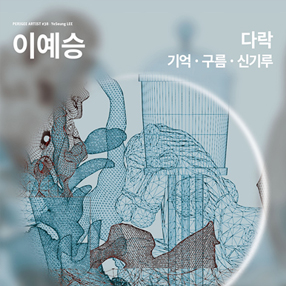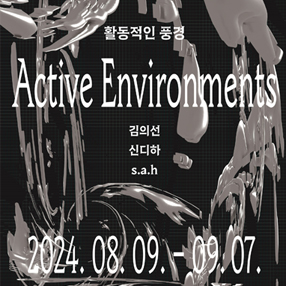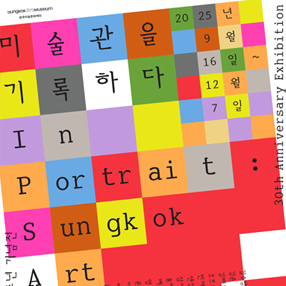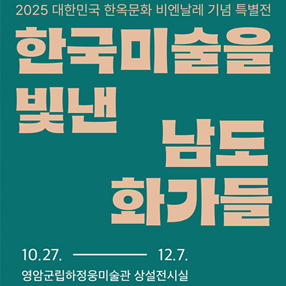본문
-
이해민선
아 깜짝이야, 2020-21, 면혼방목에 아크릴릭, 40.5x43(cm)
이해민선
사물, 2021-21, 면혼방목에 아크릴릭, 40.5x43(cm)
이해민선
사물인 줄 알았네, 2021-21, 면혼방목에 아크릴릭, 40.5x43(cm)
이해민선
그, 2021-21, 면혼방목에 아크릴릭, 40.5x43(cm)
이해민선
날, 밤, 2020-21, 면혼방목에 아크릴릭, 40.5x43(cm)
Press Release
눈이 머문 흔적들
신승오(페리지갤러리 디렉터)
이해민선의 작업에 등장하는 대상은 우리 주변에서 쉽게 발견되지만 눈여겨보지 않는 것이다. 예를 들면 겨울에 추위를 막기 위해 누군가에 의해 비닐과 스티로폼으로 얼기설기 보호되고 있는 나무나, 현수막이 바람에 찢어지지 않도록 구멍을 낸 사이로 보이는 풍경, 공사장에 무엇을 덮어놓은 지저분해진 천, 물 위에 정처 없이 떠 있는 스티로폼 같은 것이다. 이들은 어떤 목적에 의해서 만들어진 것이라는 공통점을 가지고 있다. 하지만 이것은 우리에게 그리 중요하지 않은 것, 그리고 항상 중심에 위치하기보다는 주변에 머무는 것이다. 작가는 그 대상을 마주하면서 애초에 설정된 목적과는 상관없이 자신에게 다가와 발견되는 의미들을 주목한다. 그리고 이를 주로 회화와 드로잉 그리고 설치작업으로 보여주어 왔다. 그렇다면 그가 작품에서 이야기하고자 하는 것은 소외된 대상을 중심으로 옮기기 위한 관찰의 결과인 걸까? 아니면 내 눈에 보이는 것과 보이지 않는 것의 경계를 살피는 것이었을까? 혹은 그 대상을 둘러싸고 있는 시간과 공간의 흐름을 하나의 풍경으로 느끼는 것일까? 그 어떤 것이더라도 결국 작가에게는 자신의 시선을 끌어내는 대상을 어떻게 보고 있는가가 중요하다. 하지만 그는 이를 철저한 시각에 의존한 관찰을 기반으로 그려내지 않는다. 오히려 무심코 반복되는 자신의 동선을 지나치면서 오랫동안 자연스레 볼 수밖에 없었던 대상을 수없이 내면에 쌓아 나간다. 그리고 이를 재배열하는 방식으로 그려낸다.
이번 전시의 제목인 《Decoy》(디코이)는 야생 오리를 유인하여 사냥하기 위해 연못에 띄어 놓는 가짜 미끼로, 어떤 대상을 보고 착각하게 만드는 유인체(誘引體)이다. 디코이는 가까이에서 보면 사실 가짜라는 것이 금방 인식되지만 특별한 환경에 놓이거나 먼 곳에는 이를 식별해 내기가 어렵다. 우리가 보지 않는 것들은 그 자리에 잠자코 있지만 어떤 대상을 본다는 행위로 인해 눈속임이 유발된다. 이렇게 침묵하고 있는 동시에 무엇인가 ‘나’의 시선을 이끄는 대상은 작가에 의해 만들어지는 형태와 모양, 색, 동세와 같은 여러 요소를 통해 읽히게 된다. 또한, 관객은 그들이 부여하고 싶은 의미와 해석에 따라 작품을 읽는 과정을 거친다. 이는 일시적인 이끌림의 연결로 볼 수 있다. 이와 같은 상황은 어떻게 보면 허약하고 불안정하게 보이기도 하지만 한편으로 강한 인상을 남긴다. 작가의 작업은 이렇게 어떤 대상을 인식하는 상황에서 발생하는 불확실성과 그 대상을 나와 연관 지어 판단하고 연결해 다가가는 과정에서 시작한다. 그렇다면 그가 그려내는 대상은 어떻게 나타나고 있을까? 이번 작업은 위에서 언급한 대상들이 대부분 하나의 덩어리로 나타나는데, 모두 단단하고 견고하기보다는 납작하고 가볍고 아슬아슬하게 균형을 잡고 있는 느낌을 준다. 그러면서도 명확한 경계를 통해 자신의 존재를 강하게 드러낸다. 우리에게 무엇인가가 명확하게 드러나기 직전에 시선의 밖과 안이 구분되지 않는 순간이 있다. 하지만 그렇다고 해서 실제로 어떤 경계가 무너지는 것은 아니다. 그렇기에 그의 작업에서 대상에 나타나는 명확한 경계에는 생동감이 묻어난다. 물론 작업의 시작을 가능케 하는 것은 모호함이지만 그의 작업에는 이처럼 모호함의 반대편인 명확함을 자극한다.
이제는 개별의 작업을 살펴보면서 그 구성의 흐름으로 넘어가 보자. 아홉 작품으로 이루어진 <아 깜짝이야> <사물> <사물인 줄 알았네> <그> <날, 밤> <천변에> <웅크리고 있는> <검은 등어리가> <반질반질 했다>는 문장을 분절해서 작품 제목으로 삼았다. 이는 작가가 어느 날 밤에 천변을 산책하다가 어떤 사물을 보고 착각했던 경험을 바탕으로 하였다. 스티로폼 조각은 전시 제목처럼 디코이를 연상시키는 오브제가 꽂혀 있기도 하고, 스티로폼 알갱이가 떨어져 흩어진 모습으로 둥둥 떠 있거나 어디론가 흘러가는 것처럼 보인다. 하지만 이 연작이 동일한 스티로폼인지는 알 수 없다. 또한 아홉 작품 제목들을 문장으로 연결하면 어떤 의미인지 파악할 수 있지만, 작품 하나하나를 연결하는 서사 구조로 읽어내기 힘들다. 이렇게 그의 작업은 어떤 실체를 가지고 있는 명확한 것이 아니라 우발적인 상황에 일시적으로 드러나는 것이다. 그것은 어떤 것의 표면을 재현하는 것이기도 하면서 동시에 그 겉과 곁에 존재하는 것을 현시하게 만드는 일이기도 하다. 이는 많은 시간 동안 자연스럽게 직관을 통해 축적된 것으로 작가에 의해 임의대로 재배열되고 조합되어 새롭게 인식된다. 앞에서도 언급한 것처럼 어떤 대상이 인식되는 것은 모호한 상태에서 시작되는데, 작가는 자신의 작품을 보는 관객에게 우발적인 사고를 통한 인식을 요구한다. 물론 이는 일시적인 현상에 불과하다. 하지만 이러한 시각적 경험이 어떤 대상에 대한 관심을 불러일으키고, 이러한 관심으로 인해 이미지가 축적되어 나가는 과정으로 이끈다. 이를 관객이 따라가다 보면 작가의 작업 과정을 통해 얻은 감각을 공유하게 되는 어느 순간이 발생한다. 그리고 작가의 작품에서 이것은 무엇이 되고자 하는 덩어리로 나타나게 된다. 여기서 덩어리는 <돌이 되도록>에서 돌도 아니고 원래의 스티로폼도 아닌 모습이거나, <저 덩어리>와 같이 하나의 큰 덩어리이면서 동시에 무리에서 떨어져 나온 하나의 작은 알갱이로 보인다. 이처럼 덩어리는 물리적으로 다양한 차이를 보여주는 모호한 대상이기도 하다. 이를 종합해 보면 그가 보여주는 덩어리는 <저 덩어리2_겉과 곁>, <저 덩어리3_겉과 곁>에서와 같이 자신이 경험하는 대상과 직면하는 겉이라는 표면과 그것을 항상 곁이라는 간격을 두고 꾸준히 보는 감각적 경험이 응축된 형태로 볼 수 있다.
이해민선 작업에서 덩어리는 특정한 장소에 등장한다. 예를 들면 <바깥>은 황무지 혹은 공사장 같은 대지, <돌이 되도록>과 <아 깜짝이야> 연작에서 스티로폼은 물 위에 떠 있는 모습이다. 이러한 배경은 생명력이 넘치는 자연의 풍경이 아니라 황량하고 거친 심연처럼 보인다. 그리고 작가는 대상을 화면의 중앙에 배치하고, 이러한 풍경을 추상적인 표현으로 얼버무리는 것이 아니라 그 표면에서의 시간의 흔적과 같은 얼룩, 이상한 느낌 같이 미세한 부분까지도 예민하게 반응하며 그린다. 또한 그는 작업하면서 자연스럽게 붙어버린 먼지, 그렸다 지운 붓질의 흔적, 아크릴 물감의 찌꺼기가 말라 생긴 껍질같이 자신이 만든 시간의 흔적을 고스란히 담는다. 이런 방식으로 자신에게 축적된 과거의 시간은 작가의 현재와 합쳐져 이런 덩어리로 귀결된다. 그렇다면 이 풍경 속 덩어리는 무엇인가? <자화상을 그리다가>는 지금까지 살펴본 작품에서 드러나는 작가의 태도를 고스란히 보여준다. 여기에도 어김없이 덩어리 하나가 나타난다. 작가에 의하면 자신의 모습을 그리다 보니 어떤 덩어리를 그리고 있었고, 이는 단단한 대지가 아니라 진흙과 같은 유동적인 공간에 놓이게 되었다고 말한다. 이러한 풍경과 덩어리는 결속되어 단단해져 가는가? 아니면 풀어져 분리되고 있는가? 우리의 삶은 강하건 약하건 서로에게 연결되어 있다. 이는 자연과 사물도 다르지 않다. 때로는 견고하게 고정된 것도 어느 한순간에 흔들리고, 변하여 사라지게 되는 상황이 반복된다. 우리는 이렇게 불명확한 연결의 순환 속에서 균형을 잡고 살아간다. 이렇듯 작가에 의해 드러나는 덩어리와 환경이 보여주는 형태와 질감에 의해 우리가 무엇인가를 감각하고 인지하게 되는 것은 바라보는 주체의 시선과 대상이 뒤섞여 같이 어디론가 흘러가는 혼재된 모습의 흔적이다. 따라서 <자화상을 그리다가>는 ‘나’와 우리 앞에 온전히 존재하는 것과 온전히 존재한 적도 없는 것을 포함한 이야기이다. 그렇기에 이는 단순히 작가 자신에게만 국한된 것이 아니라 우리 모두를 포함한 세상에 존재하는 것들의 자화상이 되어버린다.
지금까지 살펴본 대로 이해민선의 작업은 인간을 포함한 모든 존재가 지니고 있는 그것의 양태에 대한 관심으로 볼 수 있다. 그렇다면 그가 그려내는 이미지는 단순히 자신 앞에 존재하는 대상을 그림으로 옮기는 행위의 결과로 나타난 흔적들일까? 여기서 본다는 행위로 돌아와 보자. 어떤 대상을 바라본다는 것은 계속해서 멈추지 않고 변하는 다름을 인지하고 이를 새롭게 조합하여 연결된 이어짐을 통해 일상에 자그마한 균열을 내는 일이다. 따라서 작가가 대상을 대하는 태도는 이성적인 관념에 기대기보다는 감정에 의해 드러나는 것이다. 우리는 일반적으로 이성적인 것이 어떤 명확한 기준이 될 것이라 믿지만 사실상 그렇지 않다. 기준이란 다양한 상황에 따라 달라진다. 그렇기에 그에게 기준이 되는 것은 새롭게 이끌려 바라보게 되는 면을 직시하는 것이다. 이렇게 그가 작업으로 드러내는 것은 단순히 자신이 본 것을 재현하지 않는다. 오히려 작업으로 옮기는 과정에서 배열을 다르게 만드는 것, 혹은 어떤 의지를 갖추고 기존의 방식에서 벗어나 자신만의 방법을 찾아내는 과정에서 고스란히 나타난다. 그의 작업 방식을 예를 들면, 작가는 한 화면 안에서 그리는 대상에 따라 그것의 본질적 요소에 좀 더 적합한 표현을 찾아내고자 노력한다. 따라서 그는 여러 시리즈가 하나의 양식을 끊임 없이 유지하면서 연구하기보다는 자신의 눈앞의 대상을 가장 잘 표현할 수 있는 방식을 찾고자 한다. 이러한 맥락에서 본다는 것은 시각의 한계를 넘어 모든 것을 발가벗기는 적나라함은 없지만, 불투명했던 것을 점점 투명하게 만들어나가는 것처럼 보인다.
그의 작품에서 본다는 것은 어떤 대상의 생성과 소멸의 개념이 아니라 순환과 반복을 통해 나타나는 결과이다. 이는 갑자기 등장한 것이 아니라 오랫동안 작가에게 자연스럽게 체화된 경험을 통해 드러나는 존재의 물리적 양태와 속성, 힘의 구조, 전체와 부분, 중심과 주변에 대한 축적된 유동적 시각이다. 결국 작가는 자신이 보고 있는 것을 단순히 재현하는 것이 아니라 어떤 대상이 내 눈앞에 현존하게 만드는 일시적이고 불확실함으로 가득한 세계를 자연스럽게 그려내고자 한다. 따라서 어떤 초월적인 시선으로 그 이면에 있는 것을 바라보려 하지 않고, 자신과 맞닿아 있는 면에 충실하다. 그리고 이것은 모든 것을 이해하려는 욕망에 기인한 것은 아니다. 단지 삶 속에서 만나게 되는 익명의 것들을 바라보고 표현하는 것에 집중한 결과일 뿐이다. 이는 작가 스스로에게는 빠른 속도로 가속화되고 있고 가상과 실제의 경계를 자유롭게 넘나드는 공간적 전환이 이루어지는 지금 세상을 무감각하게 보는 것에서 벗어나기 위한 행위이기도 하다. 다시 말해 누군가에 의해 일방적으로 제공되는 이미지로 인해 자신의 눈으로 보기를 포기해 버린 상실된 눈의 회복을 바란다. 따라서 자신의 눈을 멈추지 않고 작업을 통해 세상의 흔적을 남긴다. 이를 위해서 작가는 계속해서 대상과의 거리를 유지하면서 겉과 곁을 주시한다. 이런 과정에서 작가의 내면에 깃드는 것은 어떤 대상의 표면도 이면도 아닌 모호한 상태의 덩어리로 표현된다. 그리고 이것을 지속적으로 가능하게 하는 것은 바로 여기에 존재하는 ‘그것’과 ‘나’를 동시에 자극하는 이끌림이다. 그렇기에 이해민선이 보여주는 덩어리가 있는 풍경은 ‘그것’과 ‘나’를 연결하는 이끌림에 나타나는 그 감각들을 온전히 담아내기 위해 고민하는 작가의 세상을 보는 태도가 고스란히 담겨 있다.
The Trace Eyes Stay
Seung Oh Shin, Director of Perigee Gallery
Objects in Leehaiminsun’s work are things found easily in our surroundings but often not noticed. These are things like a tree protected with vinyl and Styrofoam to keep out the cold, a landscape seen through a hole made for the banner not to be torn, filthy cloth covering something at a construction site, or styrofoam drifting aimlessly in the water. These things have something in common: they are made for some purpose. However, these are of little importance and are always located at the periphery. Seeing these objects, Lee takes notice of their meaning regardless of their initial objective. She has showcased them primarily in painting, drawing, and installation. Why does she do this? Is she trying to move an alienated thing to the center from the periphery as the product of her observation? Does she intend to investigate the boundary between the visible and the invisible? Or, does she feel the stream of time and space surrounding the object? What matters to the artist is how to see the object that attracts her attention, whatever it may be. And yet, she would not depict it based on her observation that rests thoroughly on the sense of sight. She rather piles up in her inner mind the object that she could not help but come across in her unintentionally recurring course.
Decoy, the title of this exhibition, may refer to a device used for hunting wild fowl or an attractor that belies wild ducks on a pond. If we look at it closely, a decoy is perceived to be a fake immediately, but a decoy placed in a specific situation is difficult to discern. A thing we do not see stays there as it is, but some magic is involved in this due to an act of seeing an object. The object that keeps silent and catches our eye can be read through a variety of factors such as form, image, color, and movement engendered by the artist. The viewer also goes through a process when they read an artwork depending on the meaning and interpretation they want to find. This is thought of as the continuation of a temporary attraction. On the one hand, this aspect appears vulnerable and insecure, but on the other, it leaves a strong impression behind. Lee’s work starts from the uncertainty incurred in the situation of perceiving some object and the process of evaluating and approaching the object in association with the artist. If so, what do the objects she depicts look like? The objects mentioned above appear mostly as one mass in this work. These all feel flat, buoyant, and narrowly balanced. All the while, they tellingly reveal their existence through a clear-cut border. There are moments when the inside and outside of a gaze are indistinguishable shortly before something is clearly disclosed. Nevertheless, boundaries do not actually fall apart. The clear borders of objects in her work are imbued with vitality. Her work was of course inspired by obscurity, but it stimulates definitiveness, the polar opposite of obscurity.
We review each work and go on to its composition. Nine works on display at this exhibition, such as Ah! What a Surprise!; A Thing; I think it’s a thing; That; night; at a streamside, crouching; black back; and appears glossy are entitled by dividing a few sentences. These pieces were based on her experience with an illusion she had when walking along a stream one night. A piece of styrofoam is an object reminiscent of a decoy. styrofoam granules are floating aimlessly or seem to flow away somewhere. However, there is no telling that the styrofoam used for this series is all the same. The titles of those nine works form some sentences if connected, but it is hard to read a narrative structure that integrates each piece. Like this, her work is not something obvious with some substance but something unveiled in a happenstance situation. That is to represent something’s surface and at the same time to display something that exists on or by it. That is something naturally amassed for many years and arbitrarily arranged and combined by the artist. As mentioned above, a perception of some object starts from an ambiguous state, and the artist asks viewers to perceive through accidental thinking. This is of course nothing but a transitional phenomenon. And yet, such a visual experience arouses interest in some object and images are amassed with this interest. When viewers follow this, they come across the moment they share the sense the artist has gained through the process of her work. And it appears as a mass to be something. The mass here is neither the stone nor original styrofoam in To Be a Stone. It looks like a large mass or a granule that comes from the crowd as in That Mass. Like this, the mass in her work is an obscure object that showcases various physical differences. Taken together, the mass Lee has shown is thought of as a condensed form of the sensuous experience of constantly seeing the surface and side of an object as in That Mass 2_Surface and Side and That Mass 3_Surface and Side.
A mass in Lee’s work appears in a specific site. For instance, in The Outside such a mass is placed on the earth that looks like a wasteland or a construction site while styrofoam seems to be floating on the water in series like To Be a Stone and Ah! What a Surprise. This background seems to be a desolate, rough abyss, not natural scenery suffused with life force. And Lee has sensitively reacted to some details such as stains like the traces of time and strange feelings on the surface, instead of placing an object at the center and vaguely depicting this scene as an abstract expression. She also captures the vestiges of time such as naturally adhered dust, erased brushstrokes, and crusts engendered from dried residues of acrylic paint. The past time amassed in this way results in such a mass in combination with the present time. What does the mass in this landscape look like? While Painting a Self-portrait is a work indicating her attitude. A mass also appears in this work. The artist explains that she depicts some mass while painting her self-portrait and places it not in a solid land but in a fluid space like a mud field. Is such a scene or mass being hardened? Or is it being loosen or separated? Our lives are associated with one another, be it sturdy or feeble. It is the same in nature. Things that are solidly fastened sway, change, or disappear. We are living in this cycle of vague connections, keeping our balance. What we perceive and recognize in the form and texture of a mass is the vestige of a mixture of the subject and object of our gaze. Thus, While Painting a Self-portrait conveys a story pertaining to what has existed and what has never existed. That’s why this becomes the self-portrait of not only the artist herself but also everything that exists in the world, including us.
As reviewed so far, Lee’s work is thought of as her interest in all beings including humans and their aspects. If so, are the images she portrays the products of her act of depicting an object in painting? Going back to an act of seeing, seeing some object is to perceive some changing difference and make some fissure through combination and connection. The way Lee treats an object is not dependent on any rational idea but is revealed by emotions. We tend to believe a rational thing could be some clear criteria, but actually that’s not true. Such criteria may vary depending on the circumstances. For the artist, the standard is to face up to a new perspective. Like this, she would not represent what she sees as it is. That is to arrange differently or to disclose something in the course of exploring her own way, breaking away from any established manner. In term of her way of working, she tries to find an expression more appropriate for its fundamental element depending on the object she depicts in one scene. Thus, she has tried to explore a way she can most eloquently express an object before her eye rather than constantly keeping or studying one single style in many series. In this sense seeing is likely to make the opaque transparent gradually, even though it would not unmask everything, overcoming the limitations of our sight.
Seeing in her work is not the notion of an object’s creation and extinction but the result brought forth by circulation and repetition. This rests on an amassed fluid perspective toward a being’s physical aspects and attributes, the structure of force, whole and part, and center and periphery which are naturally experienced by the artist. After all, the artist tries to naturally portray a world that is temporary and full of uncertainty, not simply representing what the artist herself is seeing. Accordingly, she is faithful to embody some aspects that touches her, not trying to see something hidden behind it from a transcendental point of view. This of course doesn’t stem from the desire to understand everything, but only the result of concentrating on seeing and expressing anonymous things she meets in her life. This is also an act to break away from seeing the world insensibly in the present when a spatial shift, through which we cut freely across the boundary between reality and imagination, is achieved. In other words, Lee wants to recover the loss of her eye, which means that she gave up seeing with her own eye due to the images being provided unilaterally by someone else. Thus, she leaves traces of the world through her work. For this, she keeps her distance from an object and takes notice of its surface and shape. What stays in her inner world in this process is neither an object’s surface nor its shape: it is presented as an obscure mass. And what makes it possible is some attraction that simultaneously stimulates ‘that’ and ‘me’. That’s why her scene with a mass demonstrates her attitude to seriously consider how to capture the sense of such an attraction between ‘that’ and ‘me’.전시제목이해민선: Decoy
전시기간2021.09.09(목) - 2021.11.06(토)
참여작가 이해민선
관람시간10:30am - 06:00pm
휴관일일요일,공휴일 휴관
장르회화
관람료무료
장소페리지갤러리 PERIGEE GALLERY (서울 서초구 반포대로 18 (서초동, (주) KH바텍 사옥) B1)
Artists in This Show
1977년 출생
페리지갤러리(PERIGEE GALLERY) Shows on Mu:um
Current Shows
























